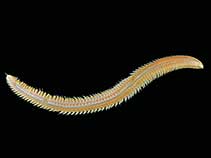Aglaophamus macroura (Schmarda, 1861)
Purple worm| Native range | All suitable habitat | Point map | Year 2050 |

|
| This map was computer-generated and has not yet been reviewed. |
| Aglaophamus macroura AquaMaps Data sources: GBIF OBIS |
Classification / Names Common names | Synonyms | CoL | ITIS | WoRMS
Polychaeta | Aciculata | Nephtyidae
Environment: milieu / climate zone / depth range / distribution range Ecology
Benthic; depth range 0 - 400 m (Ref. 87801). Polar
Distribution Countries | FAO areas | Ecosystems | Occurrences | Introductions
Southeast Pacific and the Antarctic. Subtropical to polar.
Length at first maturity / Size / Weight / Age
Maturity: Lm ? range ? - ? cm
Life cycle and mating behavior Maturity | Reproduction | Spawning | Eggs | Fecundity | Larvae
Main reference
References | Coordinator | Collaborators
Arnaud, P.M. 1974 Contribution à la bionomie marine benthique des régions antarctiques et subantarctiques. Téthys 6(3):467-653. (Ref. 86525)
IUCN Red List Status
(Ref. 130435: Version 2025-1)
CITES status (Ref. 108899)
CMS (Ref. 116361)
Threat to humans
Human uses
| FishSource |
Tools
More information
Diet composition
Food consumption
Predators
Max. ages / sizes
Length-weight rel.
Length-length rel.
Length-frequencies
Mass conversion
Abundance
Internet sources
BHL | BOLD Systems | CISTI | DiscoverLife | FAO(Publication : search) | Fishipedia | GenBank (genome, nucleotide) | GloBI | Gomexsi | Google Books | Google Scholar | Google | PubMed | Tree of Life | Wikipedia (Go, Search) | Zoological Record



